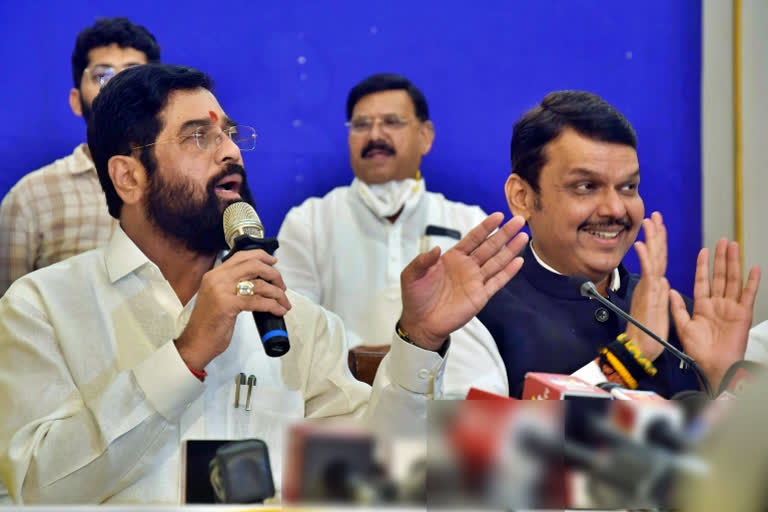Mumbai: Exit Thackeray. Enter Shinde. With the installation of Eknath Shinde as Chief Minister of Maharashtra, the election juggernaut BJP, which lost Maharashtra to the Maha Vikas Agadhi (MVA), reclaimed the state after a high-voltage drama — a classic repeat of engineering successful rebellions and rising to power on six other occasions since 2014.
The saffron party had managed to unseat the incumbent Congress combine in Madhya Pradesh, Karnataka, Meghalaya, Goa, Manipur, and Arunachal Pradesh.
The difference in the takeover template is that this time around the Supreme Court interfered and barred the Maharashtra Assembly Speaker-in-charge to decide on the disqualification plea of 16 rebel legislators including the ring leader Shinde. The Apex court which stayed the disqualification proceedings refused to stay the floor test ordered by the Governor. Shortly after the top court’s direction, Shiv Sena chief Uddhav Thackeray resigned as Chief Minister.
The impasse began with the cross-voting in Rajya Sabha elections and legislators going incommunicado to the party. The setting of the rebel MLAs extended to Gujarat’s Surat and then to Assam’s Guwahati, to Goa before arriving in Mumbai.
Madhya Pradesh
Congress, in Madhya Pradesh, outsmarted by the BJP, lost the government in 2020 following a spate of resignations and defections. Senior leader Jyotiraditya Scindia met Prime Minister Narendra Modi, and Home Minister Amit Shah. He quit Congress and joined the BJP. As many as 22 legislators, all loyalists of Scindia, tendered their resignations. While Congress had no clue of Scindia's move, they were busy trying to woo back 10 MLAs who were decamped to Haryana's Gurgaon. Both the BJP and Congress sought a floor test in the Supreme Court, which approved of the same. However, CM Kamal Nath quit becoming the last Congress CM to be ousted. BJP’s Shivraj Singh Chouhan succeeded Kamal Nath.
Karnataka
The Centrist party which became the junior partner in the alliance led by H D Kumaraswamy in 2018 began to lose the plot in 2019.
Rumblings within the alliance were loud yet the Congress high command could not do much to keep their flock together. The saffron party made its move through MLAs from the ruling dispensation to return to power. Earlier, the BJP was ousted from the seat of power in 2 days despite being the single largest party, with 105 seats in the 225 member Assembly.
As many as 18 legislators from Congres, JD(S) and a minor state party tendered their resignations facilitating the reascension of the BJP's B S Yediyurappa. Congress alleged that the resignations were machinated by the saffron party. Kumaraswamy lost the trust vote in the House and Yediyurappa was sworn in as the CM.
Meghalaya
The curious case of Meghalaya has a parallel to Karnataka — with a role reversal. Congress emerged as the single largest party with 21 seats in the 60 member house while the BJP won only two-seats. The saffron party's ally National People's Party (NPP) had won 19 seats. BJP's post-poll managed by former Union Minister Kiren Rijiju and Assam Chief Minister Himanta Biswa Sarma managed to secure the alliance with other smaller parties and managed to obtain the support of 34 legislators and install an NDA government in Meghalaya with NPP's Conrad Sangma, who was an MP back then, as its Chief Minister.
Goa
Here too Congress emerged as the single largest party bagging 17 seats in the 40-member Assembly. BJP which finished as second with 13 legislators managed to wrest out Congress and install former Defence Minister Manohar Parrikar as Chief Minister. The support of Goa Forward Party (GFP) floated by rebel Congress candidates became crucial for the BJP. Silver tongue talking by Parrikar and Union Minister Gadkari brought to fruition.
The three MLAs each from GFP and Maharashtrawadi Gomantak Party (MAG), along with Independents supported the saffron alliance following talks, while Congress was caught napping.
Manipur
Like in Meghalaya and Goa, the BJP did not have adequate numbers to form the government and has emerged as the second-largest party with 21 seats in the 60 member House. Congress tally stopped three seats short of the majority mark with 28 seats. Yet, former Congress leader N Biren Singh, who had switched to the BJP, was sworn in as the Chief Minister with the support of regional parties and a defected Congress legislator helped the party make its numbers. Here too Assam CM Sarma, a former Congress leader himself, played a crucial role.
Arunachal Pradesh
Arunachal Pradesh is the first Congress state to fall for BJP, which never stopped pulling tricks out of its hat. Congress has accrued to power with a thumping majority of 44 seats in 60 member Assembly in 2014. In a topsy turvy ride fueled by regional politics and the saffron party's contributions, the State saw three Chief Ministers - Nabam Tuki, Kalikho Pul, and Pema Khandu, in two years.
Tuki was unseated by Kalikho Pul who broke away from Congress. Pul's government which was supported by the BJP was dismissed by the Supreme Court. Later, Pul died by suicide. Tuki who became the CM was unseated by Khandu who had the support of 43 of 44 Congress MLAs and formed the People’s Party of Arunachal Pradesh (PPA). Khandu who came back to Congress later joined BJP with 33 MLAs ditching the PPA. In the 2019 Assembly elections, Khandu returned as the BJP CM winning 41 seats.



